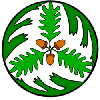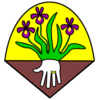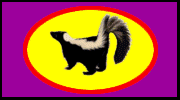
|

|

|
Fertilizer
Paul Burns, Garden Design & Education©
Fertilization can be simplified to three questions. First, do you apply a granular or a liquid fertilizer? Second, what number formulation do you apply? Third, when do you apply it?
How to Apply
Fertilizer comes in the traditional dry granular fertilizers like 10-10-10, and the more modern water-soluble fertilizers like Miracle-Gro or Peter's. Each of these has advantages and disadvantages for use. Water-soluble fertilizers are quicker acting, but will be washed away quickly in a heavy rain. Granular fertilizers are slower acting, but last longer, especially during rainy periods.
Granular fertilizers are spread dry on the ground across lawns and in and around shrubs and flowers. It is effective if you can spread it evenly, not clumpy. Spreaders like the handheld cyclone-type or the lawn push-type will give a more even coverage than broadcasting by hand. Normal rates are 50 pounds of 10-10-10 per 5000 sq. ft. Apply to dry foliage to avoid burning the plant, and apply two or three light coats, four to six weeks apart, instead of one heavy coat. Dry fertilizers require rain or irrigation to activate, but will release slower and last longer than water-soluble fertilizers.
Water-soluble fertilizers are quicker acting than dry fertilizers, because they are carried by the water that activates them. With the new applicators that go on the end of a hose, they require no mixing and get applied while you water. They need to be used frequently, every two weeks, because they will be washed away by rainfall.
I personally use a combination of each. I use a slow acting granular fertilizer as the main feeding on lawns, shrubs, and flowers. I use a water-soluble fertilizer on newly planted trees and shrubs, and as a monthly supplement on annual and perennial beds.
What the Numbers Mean
Fertilizer is labeled with three numbers representing the percentage of the three most important minerals that plants absorb. The first is Nitrogen (N) that helps build protein and strengthen the green color. The second number is Phosphorus (P) that helps store energy, and is important for roots, shoots, flowers, and fruits. The third number is the percentage of Potassium (K) or potash which is important for strong sap, disease prevention and winter hardiness.
A 10-10-10 fertilizer has 10% of nitrogen, phosphorus, and potassium, or 5 pounds of each in a 50-pound bag. 15-10-5 fertilizer has 15% of nitrogen, 10% of phosphorus, and 5% of potassium, providing 7 1/2 pounds of nitrogen, 5 pounds of phosphorus, and 2 1/2 pounds of potassium in a 50-pound bag.
Although fertilizers can come in an infinite number of combinations, there are only three main categories. The most common are balanced fertilizers such as 10-10-10 and 20-20-20 that contain equal percentages of nitrogen, phosphorus, and potassium. High nitrogen fertilizers such as ammonium nitrate (34.5-0-0) and 19-5-9 are used on lawns to provide for rapid green growth. These can be dangerous for vegetables and flowers because the rapid growth can interfere with flowering and fruiting. Low nitrogen fertilizers such as 6-12-12 and 5-10-15 are used in the fall to minimize top growth while feeding the roots and strengthening the plant for winter.
Trace Elements
While plants use great quantities of nitrogen, phosphorus, and potassium, they also need trace amounts of minerals such as iron, zinc, copper, and boron. These are important because they help fulfill the plant's mineral needs and prevents stunting due to mineral deficiencies. These are the plant's equivalents of vitamins, as opposed to the meat and potatoes of the N-P-K.
10-10-10 has the N-P-K but lacks trace elements. The better and more expensive fertilizers will contain trace elements, and list them on the bag in an ingredient/analysis list. Although using 10-10-10 or 6-12-12 is a great way to feed plants at a reasonable price, it is a good idea to feed your plants a better fertilizer containing trace elements each year to satisfy the plant's need for trace elements.
When to Apply
The final question is when to apply. This naturally relies on the type of plants you are feeding. Warm-season plants like bermudagrass, zoysia, annuals, perennials, and shrubs should be fed in the spring, summer, and sall. Feed in March or April to get them off to a good start in the spring growing season. Fertilize again in June or July to keep the plant health during the summer stress. Feed a low nitrogen fertilizer in the fall to promote root growth during the winter. Azaleas that are fertilizer around October 15th will be more winter-hardy and bloom heavier.
Cool-season plants like fescue and pansies need three fertilizations, but at different times. The first is in September or October at the start of the cool-season. The second application is in November or December, while the third is in February or March. Many people split the feedings into two halves and skip the middle feeding.
Houseplants are feed on the warm-season plant schedule.
Lime
Dolomitic limestone, in the white powder or grey pellets, contains calcium (Ca) and magnesium (Mg) which are the fourth and fifth most important minerals that plants absorb. They help the plant build strong sap for disease prevention. Lime also regulates the pH of the soil, making acid soil more alkaline. While many of our popular shrubs like azaleas, camellias, and rhododendron are acid-loving and don't like lime, most flowers and vegetables like to be limed moderately, and lawns love lime. Since rain washes away lime, it is a good idea to reapply lime annually.
The best way to determine the precise dosages of lime and fertilizer needed for a lawn is to take a soil sample to the County Extension Service for a $ 4.00 soil test. If you don't want to wait for the test results, you can use a 40 pound bag for each 1000 square feet on new or rarely limed lawns, or 20 pounds per 1000 square feet on flower beds, vegetable gardens, and frequently limed lawns.
Paul Burns, Garden Design & Education
1996-2005©
 |
Paul Burns Atlanta, Georgia, USA |

Don't Tread on Me! |